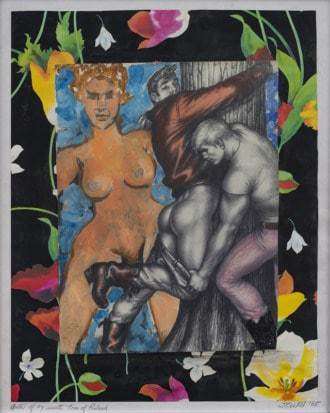
A collage is a composite image, made up of two or more materials to create something whole. At the Leslie-Lohman Museum of Gay and Lesbian Art in New York, a new exhibition is on display. Cut-Ups: Queer Collage Practices showcases the work of a number of artists who use paper as their primary medium.
“This show is rooted in a love of materiality and craft found in collage,” said curator David Evans Frantz. “The process of collage involves touching, cutting, affixing, and smoothing out—all forms of handling.”
Some displays combine pornography with images from interior design magazines or other forms of visual art. The origin of this combination dates back to early gay pornographic magazines, which were used to discuss LGBTQ culture before the existence of public queer spaces.
“Liberation-era gay porn magazines often integrated lifestyle articles and arts coverage alongside nude pictorials,” said Frantz, “reflecting that readers’ sex lives were not separated from their broader lives or identities as gay men.”
One artist, Jonathan Molina-Garcia, uses his own self-portraits alongside images of older, HIV-positive men, while artists Enrique Castejon and Jade Yumang use historical print sources from older magazines and other images, creating a surrealist, more fragmented depiction of the queer human figure.
In addition to symbols of queer male identity, there are a number of feminist and lesbian collages that play with phallic images and gender nonconformity.
Anita Steckel combines self portraits with sharp, masculine images reminiscent of Tom of Finland, whose artwork was homoerotic and fetishized, and which influenced gay culture throughout the 20th century and beyond.
While each piece is mainly created with paper media, the use of ink, paint, graphite and pastels creates striking contrasts between subjects within the same piece. These combination of themes often seem somewhat conflicting, subjective, and flexible. They are strikingly different, yet similarly lustful, and elicit many feelings depending on the eye of the beholder. They play with the art of gender-bending — the pinnacle of queer identity.
Cut-Ups: Queer Collage Practices will be on display until Dec. 18, 2016.
